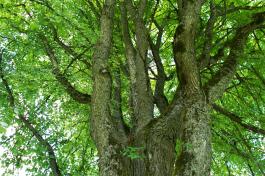Coastal Redwood
Sequoia sempervirens
Learn about the Coastal Redwood including when and why it was planted, how to identify it, and where to find it on campus.

Tree Facts
Traits
- Fern-like, soft foliage
- Thick, reddish-brown bark with deep furrows
- One inch long, woody cones with thick, wrinkled scales
- Burls (round growths on the trunk) are common
Native Range
- Coasts of Northern and Central California and Southwest Oregon
Story of the Tree
The coastal redwood is one of three members of the redwood family that found on Capitol Campus. A new tree was planted on campus in 2020 as part of a program to reintroduce this tree to its pre-Ice Age range, which extends along the entire Pacific Northwest coast.
The coastal redwood is the tallest growing tree species in the world, reaching heights close to 400 feet.
The scientific name is Sequoia sempervirens. "Sequoia" honors the Native American Cherokee Chief Sequoyah, and "sempervirens," means "evergreen."
This tree's bark, which can be over a foot thick, helps it survive most wildfires, and the burls (round growths on the trunk) can sprout new shoots.







